This is a Super Paxette II BL 35mm rangefinder camera made by Carl Braun Kamera-Werke of Nuremburg, Germany starting in 1958. This was one of the last, and most advanced in Braun’s successful line of Paxette cameras dating back to the original Paxette I from 1950. This model has an interchangeable lens mount, coupled coincident image rangefinder, and a uncoupled Bewi selenium cell exposure meter all contained in a very compact body.
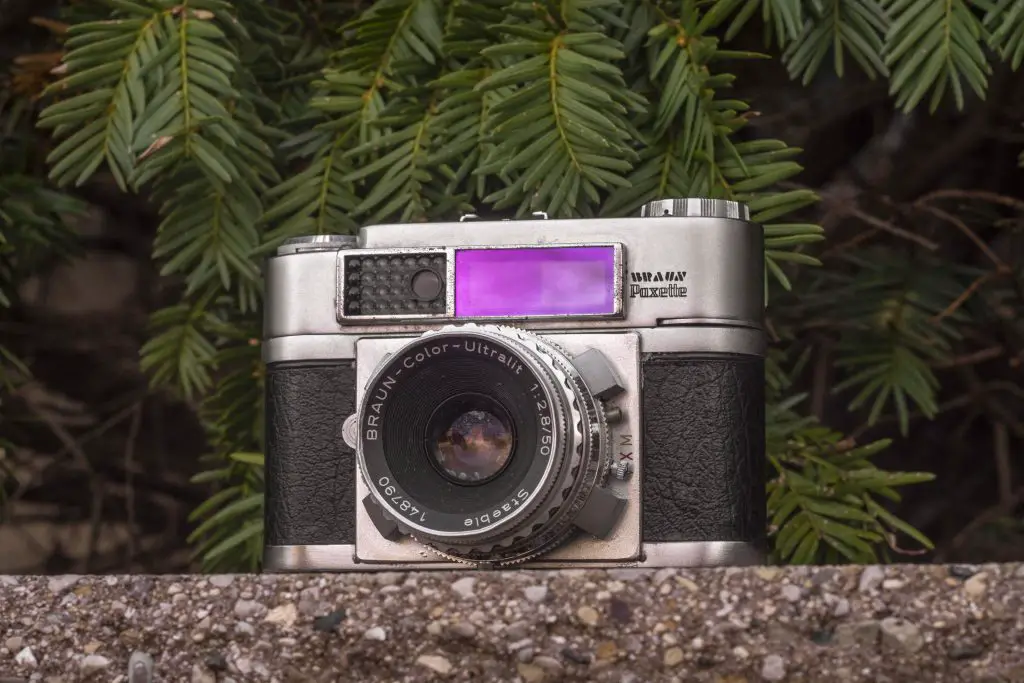
Film Type: 135 (35mm)
Lens: 50mm f/2.8 Braun-Color-Ultralit coated 4-elements
Lens Mount: M39 Screw Mount (not compatible with the Leica Thread Mount)
Focus: 3 feet to Infinity
Viewfinder: Coincident Image Coupled Rangefinder w/ Projected Framelines for 50mm, 85mm, and 135mm lenses
Shutter: Prontor-SVS Leaf
Speeds: B, 1 – 1/500 seconds
Exposure Meter: Uncoupled Bewi Selenium Cell w/ top plate match needle
Battery: None
Flash Mount: Coldshoe and M and X Flash Sync
Weight: 672 grams
Manual: http://www.cameramanuals.org/pdf_files/braun_paxette_super_iibl.pdf
How these ratings work |
The Super Paxette II BL was a high quality 35mm camera with a competitive feature set, including an interchangeable lens mount, built in light meter, and coupled rangefinder. The body is very solid and compact, yet has everything you’d need to make excellent photographs. With a range of high quality lenses, the Super Paxette has a nice balance of quality and portability making it a great tag-a-log camera for trips to the family zoo or other places where a large camera might get in the way. The example reviewed here wasn’t in the best of condition, but despite it’s woes, was a pleasant and fun to use camera that made good images. | ||||||
| Images | Handling | Features | Viewfinder | Feel & Beauty | History | Age | |
| 1 | 2 | 1 | 1 | 2 | 0 | 30% | |
| Bonus | none | ||||||
| Final Score | 9.1 | ||||||
History
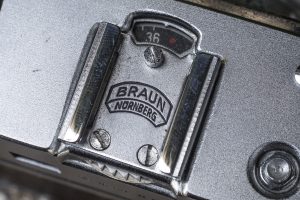
Braun was a maker of mostly compact 35mm scale focus and rangefinder cameras in the 1950s and 60s. Although also from Germany, a separate company called Braun founded in 1921 in Frankfurt by a German inventor named Max Braun as a maker of radios, electric shavers, and small appliances does not appear to be related. The Braun photo company was based out of Nuremberg (Nürnberg), Germany in the German state of Bavaria. There is conflicting information about the origins of this company online, some saying the company was founded in 1906, and others in 1915 as Karl Braun KG. I am inclined to believe the 1915 date as this is the date stated on the current day Braun’s official website.
Regardless of which date is correct, most sites state that Braun’s earliest products were not camera related, but rather were optical products like binoculars, scopes, and other various products for the radio industry. There is surprisingly little information about the company during this period or any evidence of products showing up for sale with a Braun name, so its also possible that they were a “white label” supplier for other companies. This is just speculation though.
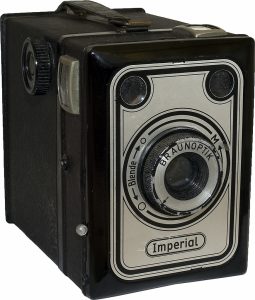
In 1948, the company would change it’s name to Carl Braun Kamera-Werke Nürnberg and would release it’s first box cameras under the name “Imperial Box”. The first models shot 6×9 images, but a later variant shot 6×6.
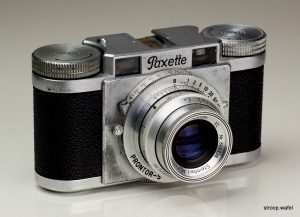
In 1950, Braun ventured into 35mm cameras with the first Paxette, a compact solid bodied 35mm scale focus camera. The front of the original Paxette had twin viewfinders which make them look like they have a rangefinder, but in fact, the window on the photographer’s right side is an extinction meter for calculating exposure.
Throughout the 1950s, the Paxette would go through a rapid and confusing series of upgrades and revisions. Braun released a huge number of Paxette variants with seemingly identical features, but with lens and shutter combinations supporting a huge number of lens makers from little known companies like Roeschlein-Kreuznach to top tier companies like Zeiss.
Later Paxettes would have several different interchangeable lens mounts, the first was a 39mm screw mount that supported a number of accessory lenses designed for the Paxette. Although physically identical to the M39 “Leica Thread Mount” used by focal plane rangefinders, due to the need for the lens to sit farther away from the film plane because of the leaf shutter, Paxette screw mount lenses are not compatible with Leica screw mount lenses. Any attempt to mount a Leica lens on a Paxette (or vice versa) will result in badly out of focus images. Later Paxettes would feature rangefinders, first in uncoupled designs, and later coupled. Rangefinder equipped Paxettes would always be called “Super” Paxettes.
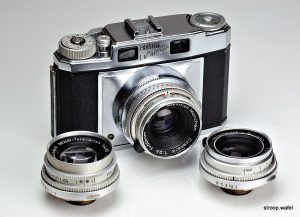
After the screw mount Paxette, Braun would release cameras with no less than three different bayonet mounts in a short period of time from the late 1950s to the early 1960s. A model called the Braun Paxette Super III Automatic would share a similar, but not identical, bayonet mount with the King Regula Super, and Photavit 36. The Paxette IA Electromatic used something called the Paxette bayonet which was not used on any other camera made by Braun or anyone else. Finally, Braun’s last rangefinder model, the Braun Super Colorette II, didn’t use the Paxette name, but had something called a Deckel bayonet, which was shared by the Kodak Retina series, and other cameras made by Iloca, Wittnauer, and Voigtländer. For more information, including several excellent photos of the various mounts, check out Cees-Jan de Hoog’s excellent Paxette page.
Although Braun would make a few other types of cameras besides the Paxette series, these were the brand’s biggest successes and the ones they are most well known for. Despite being made by a relatively small newcomer to the post war German camera industry, Paxettes were well built and very affordable, often having features typically reserved for more expensive cameras.
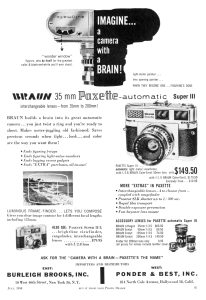
I couldn’t find any sales figures or info about how much these cameras might have cost when new, but the ad to the right from August 1958 for the Braun Paxette Automatic, has a little insert in the corner for the meterless Paxette Super II L for $79.95 which suggests that the metered version likely sold for a little more, perhaps $89.95.
In 1954, Braun would expand their product portfolio to Slide Projectors with the first Braun Paximat projector. This proved to be a wise decision as it is an industry that the company would remain in through the start of the 21st century. The Paxette series would continue until the mid 1960s at which time, Braun would license their name out to less expensive third party Japanese makers. By the end of the 1960s, the company would exit the camera business altogether, instead focusing on other optics goods.
Today, Braun isn’t a name too highly regarded by collectors, but it’s hard to collect cameras and not run into at least one Paxette. The cameras themselves were quite well built and eschewed the trend to look like more expensive models made by the likes of Leitz or Zeiss. Paxette cameras have their own look and when found in working condition are generally capable of good results, making them a worthy pickup for the right price.
My Thoughts
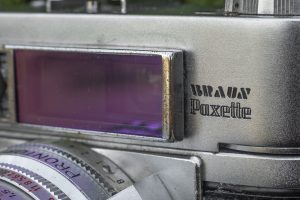
The Braun Super Paxette II BL was made during my favorite era of 35mm rangefinder design. The late 1950s were a period of big change for camera makers. The advent of automatic exposure was sweeping the industry, making cameras more capable (and appealing) than ever before, but there was also a switch to smaller and more compact cameras with larger and brighter viewfinders. The AGFA Optima series, Altissa Altix, and Fujica 35 are all examples of fully manual 35mm rangefinders with compact bodies and excellent viewfinders.
This Braun came to me in non working condition. The camera clearly had a rough life evidenced by a lot of little scratches, a dented filter ring, areas of the chrome plating that showed signs of corrosion, the viewfinder was extremely dirty, the shutter was stuck, and the wind lever was jammed. On the plus side, the purple-tinted cover over the viewfinder windows was still in tact. These cameras are often found with this missing as apparently it’s easy to fall off.
Of the usability issues, I was able to remedy two of three problems. Being an interchangeable lens camera meant I just had to detach the lens and squirt some lighter fluid in there to free up the shutter, and removing the top plate allowed me to clean the viewfinder. The issue with the wind lever turned out to be that a coiled spring that is designed to put tension on the wind lever and have it spring back to it’s original position had come loose and was flopping around in there causing the lever to jam when winding the camera. Despite my best efforts, I could not figure out how to get the spring correctly attached. Perhaps if I had another good camera to look at, I might have been able to figure it out, but I decided that since I couldn’t fix it, and it was making the camera worse, I just removed the spring altogether and put it back together. Unfortunately, I did not take any pics of the repairs so I have nothing to show. With the spring completely removed, the wind lever moved smoothly now, although there is no tension on it after winding, so you have to help it back.
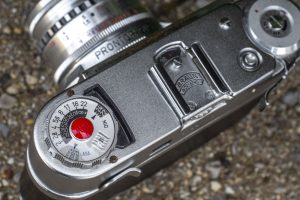
When looking at the top of the camera, your eye is instantly drawn to the red dot adorning the center of the Bewi light meter. The meter uses a match needle system but is not coupled to either the selected shutter speed or aperture values on the lens. In order to use the meter, you have to turn the dial around the meter which controls the red pointer, and get it to lineup with the white needle which is connected to the meter. The only setting that you need to be aware of is the film speed dial. With the correct film speed set, and the red pointer lining up with the white needle, you the look at the various combinations of shutter speeds and f/stops indicated on the meter and pick whichever one suits the situation you re shooting in. You might see 1/30 @ f/11, or 1/60 @ f/8, or 1/125 @ f/5.6 and these would all indicate the same correct exposure (assuming you did everything right). For a photographer used to more advanced coupled meters which were common in cameras that came after this, it might seem difficult to do, but it really isn’t. This is almost exactly the same process you would use had you used a hand held or clip-on light meter.
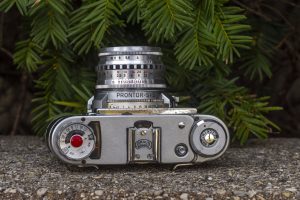
The rest of the top plate features an accessory shoe, the exposure counter, rewind release button, rapid wind lever, and a film type reminder dial. The exposure counter does not automatically reset when the film back is opened, so there is a small toothed wheel immediately behind the accessory shoe which must be manually turned to reset the counter each time new film is loaded. The counter works backwards like the Kodak Retina series in that you set it to the number of remaining exposures left on a roll and it counts down to 1. Unlike the Retina however, when the counter gets to 1, it does not lock the shutter release. The rapid wind lever requires two strokes, actually more like one and a half, to properly advance the film and cock the shutter.
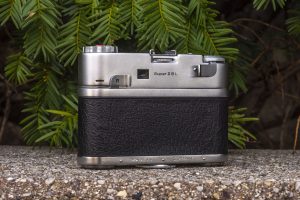
The back of the camera shows the viewfinder window, and both the rapid advance lever and the rewind lever. This camera is one of the only that I know of that uses a lever for both wind and rewind. This was most likely done so that there would be room for the light meter to be placed on the top plate and on paper seems like a great idea, but in practice, I found it quite awkward and slow. Each wind of the lever turns the spool inside the film cassette about half of a turn. This means that if you have a 36 exposure roll of film loaded, you’re going to be winding that lever quite a few times in order to get to the beginning of the roll.

Flipping the camera over, we see the standard 1/4″ tripod socket surrounded by a large circle with a knurled edge around the perimeter which is the film back release. Like the Altissa Altix, you must unscrew this ring in order to release the back of the camera from the body. It’s not hard to do, but isn’t obvious the first time you handle the camera. The only other things on the bottom of the camera are two round “feet” which slightly elevate the camera when setting it down on a flat surface to make room for the round door release.
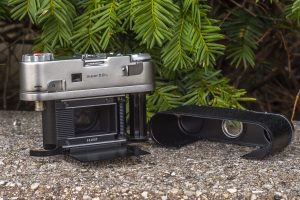
Once you’ve unlocked the film compartment, the entire back and bottom come off as one piece. The film pressure plate is hinged on the bottom and folds down when the back is removed, once again similar to the Altissa Altix.
The film back wraps around to the front of the camera similar to the Voigtländer Vitessa, so when it’s removed, the camera looks almost as if you’ve partially disassembled it. This has two benefits. The first is that there is plenty of room to load film into the camera. There is no cramped compartment to which you need to insert a new cassette, but also, the possibility of light leaks are essentially eliminated as the point of contact between the back and the body is in the front of the camera, and not the side where the film would be. The Paxette also pre-dates the use of foam light seals, and the fabric ones that came on this camera did not need replacement.
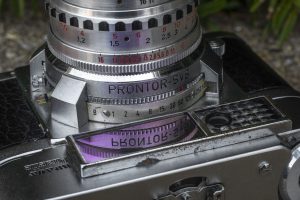
Changing the settings on the camera is all done on the shutter and lens. You’re not going to believe this, but the Braun Super Paxette II BL is similar to the Altissa Altix yet again in that it not only uses an interchangeable lens mount, but that also the order in which the controls are from the body are shutter speed selector, focus ring, and then aperture ring. I prefer this arrangement as I tend to use Sunny 16 often, and once I set a shutter speed, I rarely change it. I’m more likely to change the focus of the camera and aperture settings as distance and lighting conditions change. Although not shown well, there is also a self timer (indicated by a “V”) on the side of the lens for those instances where a delayed shutter would be useful.
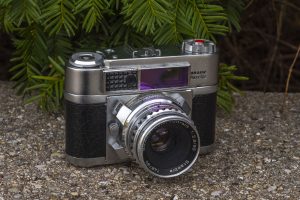
The shutter release lever is also found on the shutter itself at approximately the 9 o’clock position when looking at the front of the camera. This location means that it is comfortably reachable with the index finder of the photographer’s right hand when the camera is held to the eye.
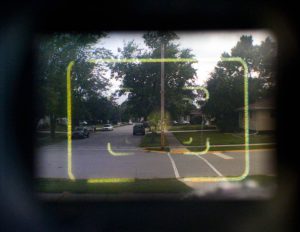
With the camera to your eye, the viewfinder is large and features a yellow tinted circular rangefinder patch, and 3 sets of projected frame lines for the various 50mm, 85/90mm, and 135mm lenses made. For the wide angle 35mm lens, the entire viewfinder image can be used for this focal length. I found the viewfinder a bit cluttered, but easy to use. I only had access to the Braun-Color-Ultralit 50mm lens so I can’t comment on using any other focal lengths.
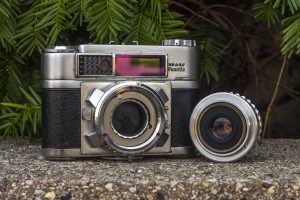
If you are lucky enough to find one of these cameras with any of the available accessory lenses, swapping them is quite easy. The Super Paxette II BL uses a simple screw mount, so just grip the middle of the lens and unscrew it “lefty loosey”, and it will come off. The lens mount uses a 39mm x 1 thread which is identical to the Leica Thread Mount, but the Braun lenses were designed for a different distance between the lens and the focal plane inside of the camera, so mounting a Leica lens to the Braun, or vice versa, will return badly out of focus images.
The Braun Super Paxette II BL was one of the last of the Paxette line and represents the best of what the company could offer at the time. This is a very well made camera, and it is impressive how many features were included in such a compact body. Although weighing a reasonable 672 grams, the overall size of the camera is quite compact which gives the illusion that the camera is heavier than it really is.
I was disappointed the camera wasn’t in better condition, but ‘beggars cant be choosers’ as they say. This camera came to me at very little cost and in non-working condition so the fact that it worked at all was a miracle. Not knowing how long it would continue to operate, I decided I shouldn’t wait too long before shooting it.
My Results
For the first roll through the Braun, I chose a roll of Fuji Superia 400 film and took it with me on a trip to upper Michigan this past winter. In hindsight, the color palette up there around that time of the year generally doesn’t offer the best selection of colors, so black and white film might have been a better choice, but what’s done is done.
Shooting a camera for the first time during the winter months is always a tricky thing. For one, lighting isn’t always ideal, but also, colors are generally lacking. This has a side effect of me wanting to try shooting film indoors, which when using old cameras without a flash is risky.
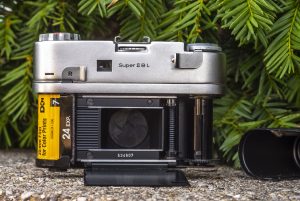
The images above represent the best of a 12 exposure roll I shot in the Braun and I really feel as though I didn’t do the camera justice. I thoroughly enjoyed using the camera and feel like I should have tried harder. Despite the lack of a return spring on the film advance lever, the camera was a joy to use, and typing this review now in August, I realize that I’ve let this sit far too long in draft status. Whenever I get around to shooting more film in this camera, I’ll be sure to update this review.
As I referred to multiple times earlier in this review, the Super Paxette shares a lot of similarities to the Altix Altissa-nb that I have previously reviewed. Both are approximately the same size, have a completely removable back with a folding pressure plate, both have an uncoupled meter built into the top plate (although the meter on my Altix was dead), an interchangeable lens mount unique to each camera, and a leaf shutter with controls in the same orientation. The only real difference in use between the two is that the Altix is scale focus only and the Super Paxette has a rangefinder.
I quite liked the Braun Super Paxette II BL and am glad it is in my collection. I would not hesitate to pick up another in better condition, but for now, this sample will suit me fine. It is a very solid and compact German camera that is fun to use, and rife with quirks that make the shooting experience a memorable one. While I’m not impressed with the compositions of my images, I can’t fault the camera for that. Based on what I’ve seen though, I think that with a better attempt, I’d get some really fantastic images from this camera.
Additional Resources
http://www.cjs-classic-cameras.co.uk/paxette/paxette.html
http://camerapedia.wikia.com/wiki/Braun_Super_Paxette_II
http://retinarescue.com/paxettesuper2land2bl.html
https://www.photo.net/discuss/threads/a-really-super-paxette.416367/
https://www.rangefinderforum.com/forums/showthread.php?t=123080

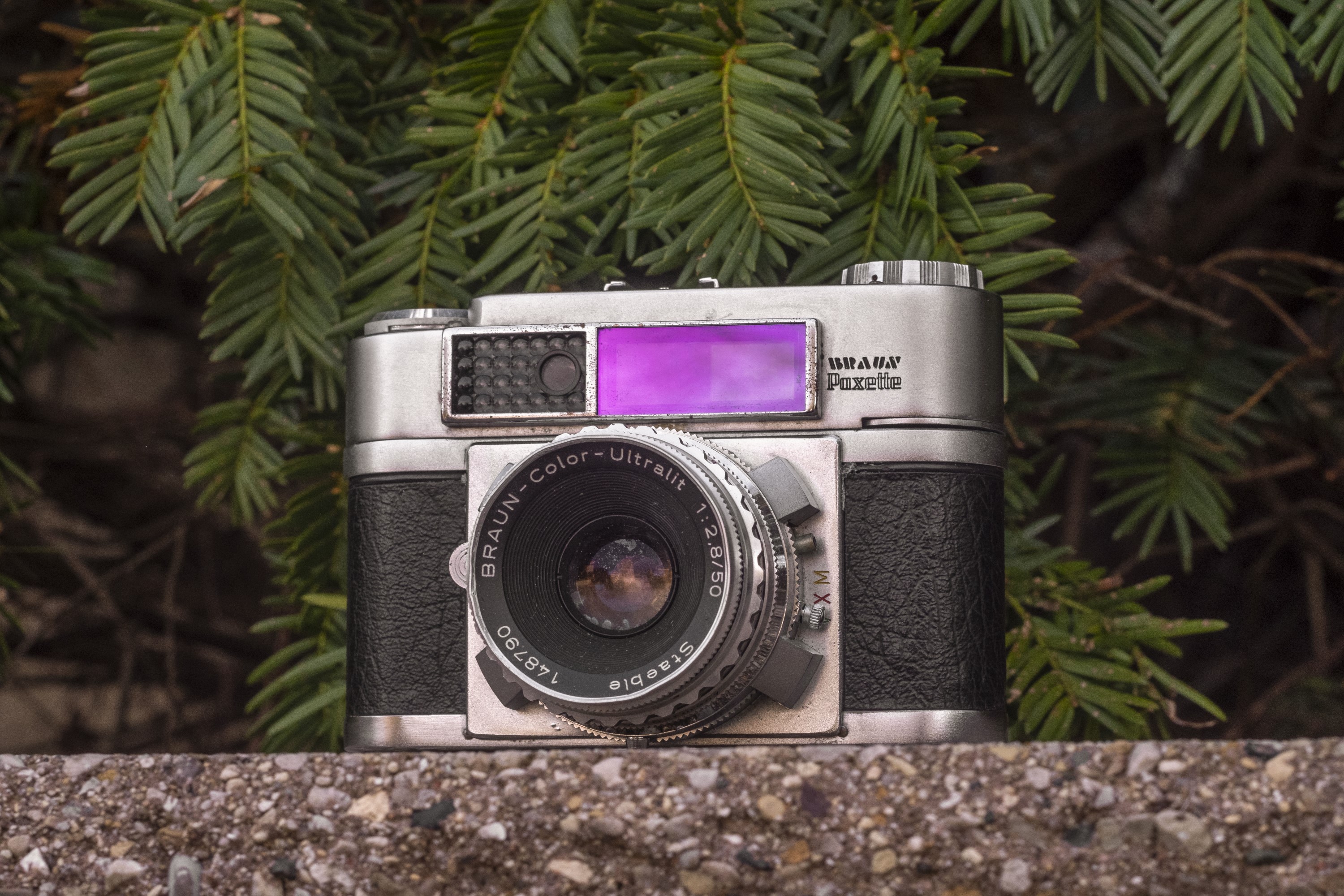
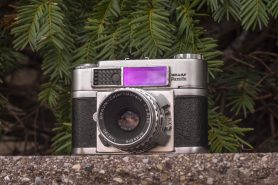








Good article, Mike. I think you got a bit bit mixed up when you were writing the party about the different mounts, though? The Colorette were a separate camera line from the Paxette. So, the Paxette didn’t come in three different bayonet mounts, but two****.
Also, the bayonet mount used in the Colorette was called the Deckel Mount, not the Compur mount. Deckel being the company which produced compur (and other) shutters.
****Unless there was a Deckel mount version of the Paxette. I’ve never seen or heard of such a thing, though.
Chris, thank you for the correction. That was the last section of the review I typed last night and my mind was probably wandering! I have corrected that part of the article! 🙂
Thanks for your wonderful sharing.I learned a lot from you.